Analyzing the Economic and Social Impact of Remittances in Nepal
VerifiedAdded on 2020/04/01
|15
|4032
|391
Report
AI Summary
This report investigates the socio-economic impact of remittances and emigration on Nepal. It examines the increase in foreign employment and its correlation with the rise in remittances, which have significantly boosted Nepal's GDP. The study explores key concepts, including the definition a...
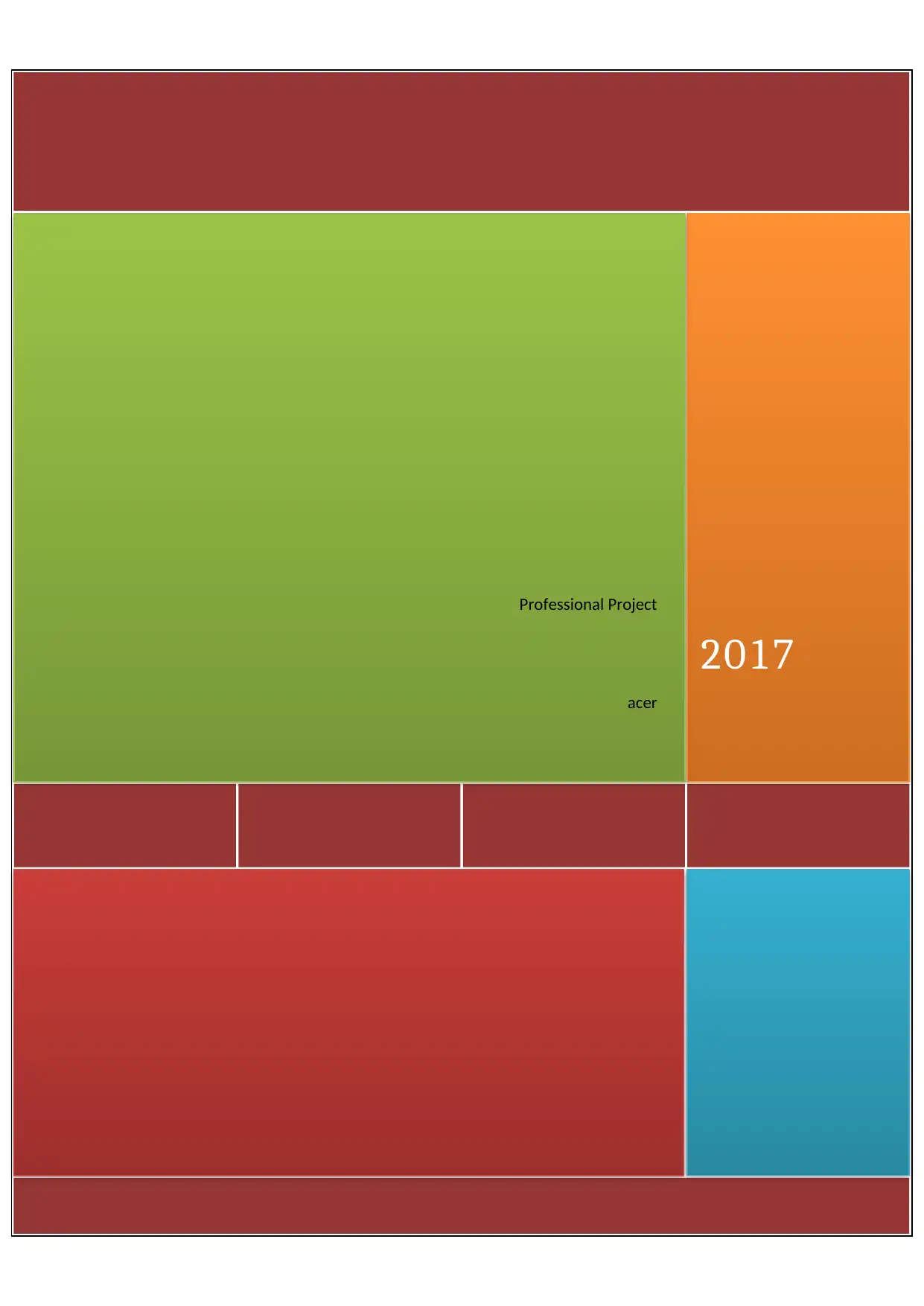
Professional Project
acer
2017
acer
2017
Paraphrase This Document
Need a fresh take? Get an instant paraphrase of this document with our AI Paraphraser
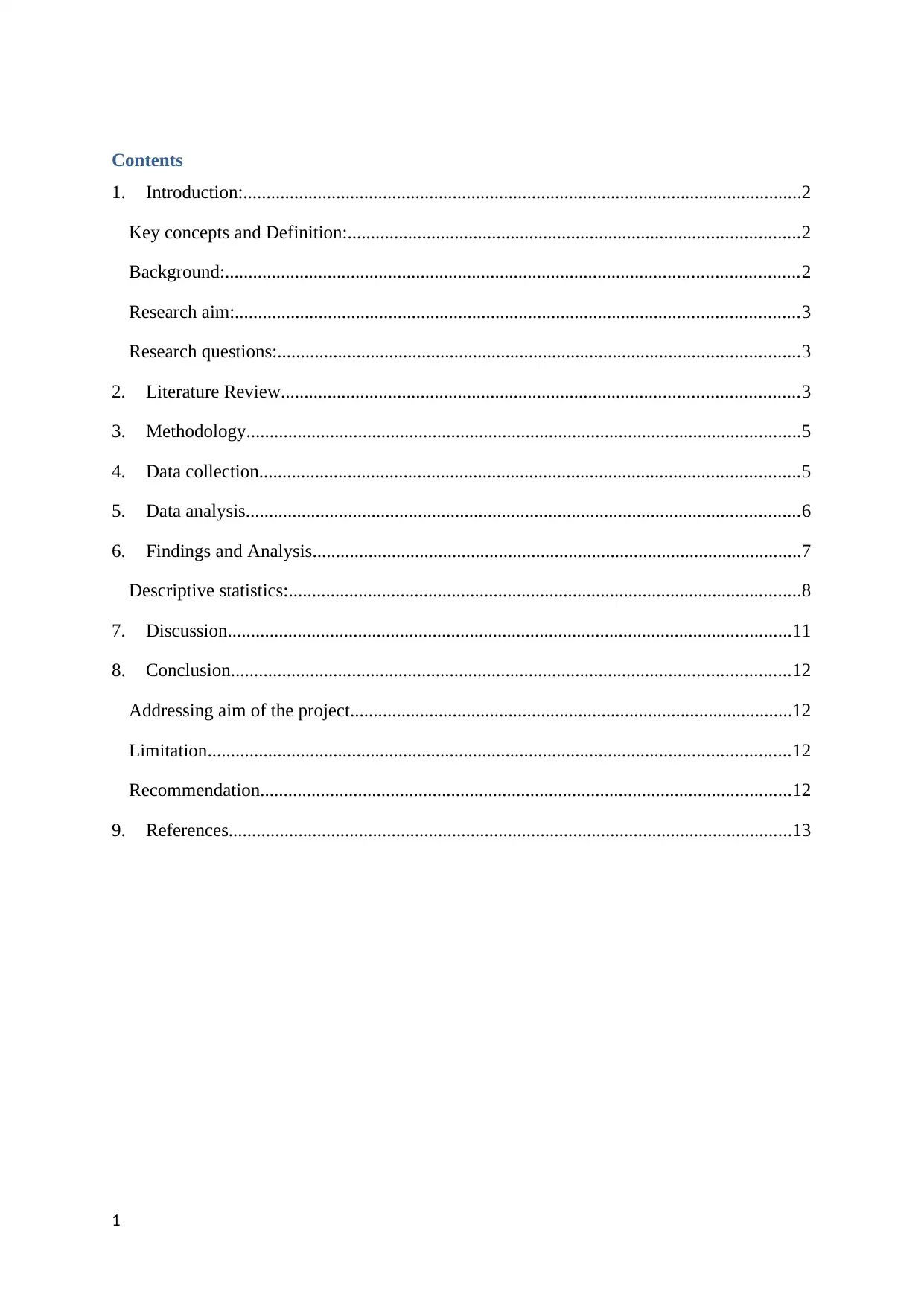
Contents
1. Introduction:........................................................................................................................2
Key concepts and Definition:.................................................................................................2
Background:...........................................................................................................................2
Research aim:.........................................................................................................................3
Research questions:................................................................................................................3
2. Literature Review...............................................................................................................3
3. Methodology.......................................................................................................................5
4. Data collection....................................................................................................................5
5. Data analysis.......................................................................................................................6
6. Findings and Analysis.........................................................................................................7
Descriptive statistics:..............................................................................................................8
7. Discussion.........................................................................................................................11
8. Conclusion........................................................................................................................12
Addressing aim of the project...............................................................................................12
Limitation.............................................................................................................................12
Recommendation..................................................................................................................12
9. References.........................................................................................................................13
1
1. Introduction:........................................................................................................................2
Key concepts and Definition:.................................................................................................2
Background:...........................................................................................................................2
Research aim:.........................................................................................................................3
Research questions:................................................................................................................3
2. Literature Review...............................................................................................................3
3. Methodology.......................................................................................................................5
4. Data collection....................................................................................................................5
5. Data analysis.......................................................................................................................6
6. Findings and Analysis.........................................................................................................7
Descriptive statistics:..............................................................................................................8
7. Discussion.........................................................................................................................11
8. Conclusion........................................................................................................................12
Addressing aim of the project...............................................................................................12
Limitation.............................................................................................................................12
Recommendation..................................................................................................................12
9. References.........................................................................................................................13
1
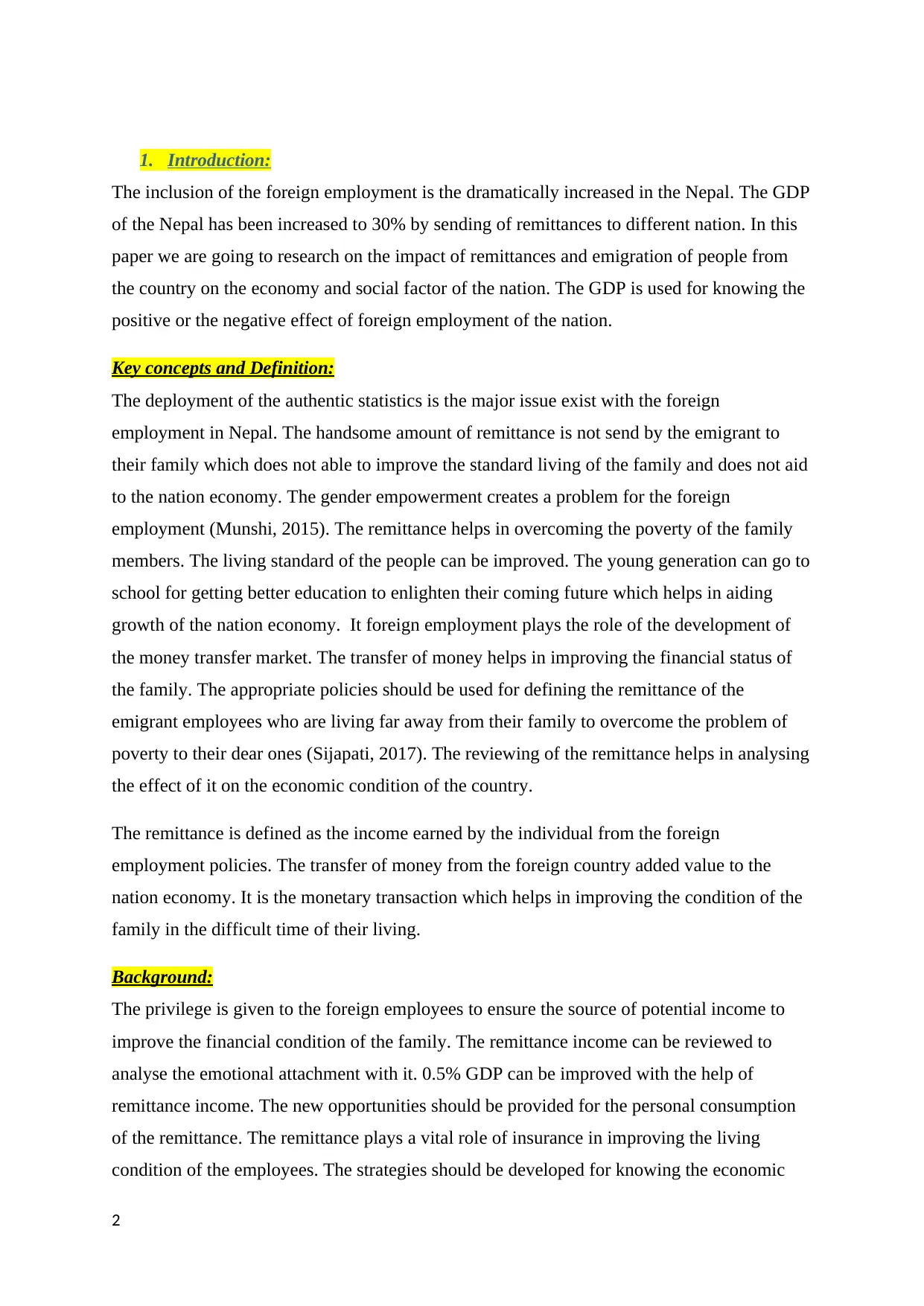
1. Introduction:
The inclusion of the foreign employment is the dramatically increased in the Nepal. The GDP
of the Nepal has been increased to 30% by sending of remittances to different nation. In this
paper we are going to research on the impact of remittances and emigration of people from
the country on the economy and social factor of the nation. The GDP is used for knowing the
positive or the negative effect of foreign employment of the nation.
Key concepts and Definition:
The deployment of the authentic statistics is the major issue exist with the foreign
employment in Nepal. The handsome amount of remittance is not send by the emigrant to
their family which does not able to improve the standard living of the family and does not aid
to the nation economy. The gender empowerment creates a problem for the foreign
employment (Munshi, 2015). The remittance helps in overcoming the poverty of the family
members. The living standard of the people can be improved. The young generation can go to
school for getting better education to enlighten their coming future which helps in aiding
growth of the nation economy. It foreign employment plays the role of the development of
the money transfer market. The transfer of money helps in improving the financial status of
the family. The appropriate policies should be used for defining the remittance of the
emigrant employees who are living far away from their family to overcome the problem of
poverty to their dear ones (Sijapati, 2017). The reviewing of the remittance helps in analysing
the effect of it on the economic condition of the country.
The remittance is defined as the income earned by the individual from the foreign
employment policies. The transfer of money from the foreign country added value to the
nation economy. It is the monetary transaction which helps in improving the condition of the
family in the difficult time of their living.
Background:
The privilege is given to the foreign employees to ensure the source of potential income to
improve the financial condition of the family. The remittance income can be reviewed to
analyse the emotional attachment with it. 0.5% GDP can be improved with the help of
remittance income. The new opportunities should be provided for the personal consumption
of the remittance. The remittance plays a vital role of insurance in improving the living
condition of the employees. The strategies should be developed for knowing the economic
2
The inclusion of the foreign employment is the dramatically increased in the Nepal. The GDP
of the Nepal has been increased to 30% by sending of remittances to different nation. In this
paper we are going to research on the impact of remittances and emigration of people from
the country on the economy and social factor of the nation. The GDP is used for knowing the
positive or the negative effect of foreign employment of the nation.
Key concepts and Definition:
The deployment of the authentic statistics is the major issue exist with the foreign
employment in Nepal. The handsome amount of remittance is not send by the emigrant to
their family which does not able to improve the standard living of the family and does not aid
to the nation economy. The gender empowerment creates a problem for the foreign
employment (Munshi, 2015). The remittance helps in overcoming the poverty of the family
members. The living standard of the people can be improved. The young generation can go to
school for getting better education to enlighten their coming future which helps in aiding
growth of the nation economy. It foreign employment plays the role of the development of
the money transfer market. The transfer of money helps in improving the financial status of
the family. The appropriate policies should be used for defining the remittance of the
emigrant employees who are living far away from their family to overcome the problem of
poverty to their dear ones (Sijapati, 2017). The reviewing of the remittance helps in analysing
the effect of it on the economic condition of the country.
The remittance is defined as the income earned by the individual from the foreign
employment policies. The transfer of money from the foreign country added value to the
nation economy. It is the monetary transaction which helps in improving the condition of the
family in the difficult time of their living.
Background:
The privilege is given to the foreign employees to ensure the source of potential income to
improve the financial condition of the family. The remittance income can be reviewed to
analyse the emotional attachment with it. 0.5% GDP can be improved with the help of
remittance income. The new opportunities should be provided for the personal consumption
of the remittance. The remittance plays a vital role of insurance in improving the living
condition of the employees. The strategies should be developed for knowing the economic
2
⊘ This is a preview!⊘
Do you want full access?
Subscribe today to unlock all pages.

Trusted by 1+ million students worldwide
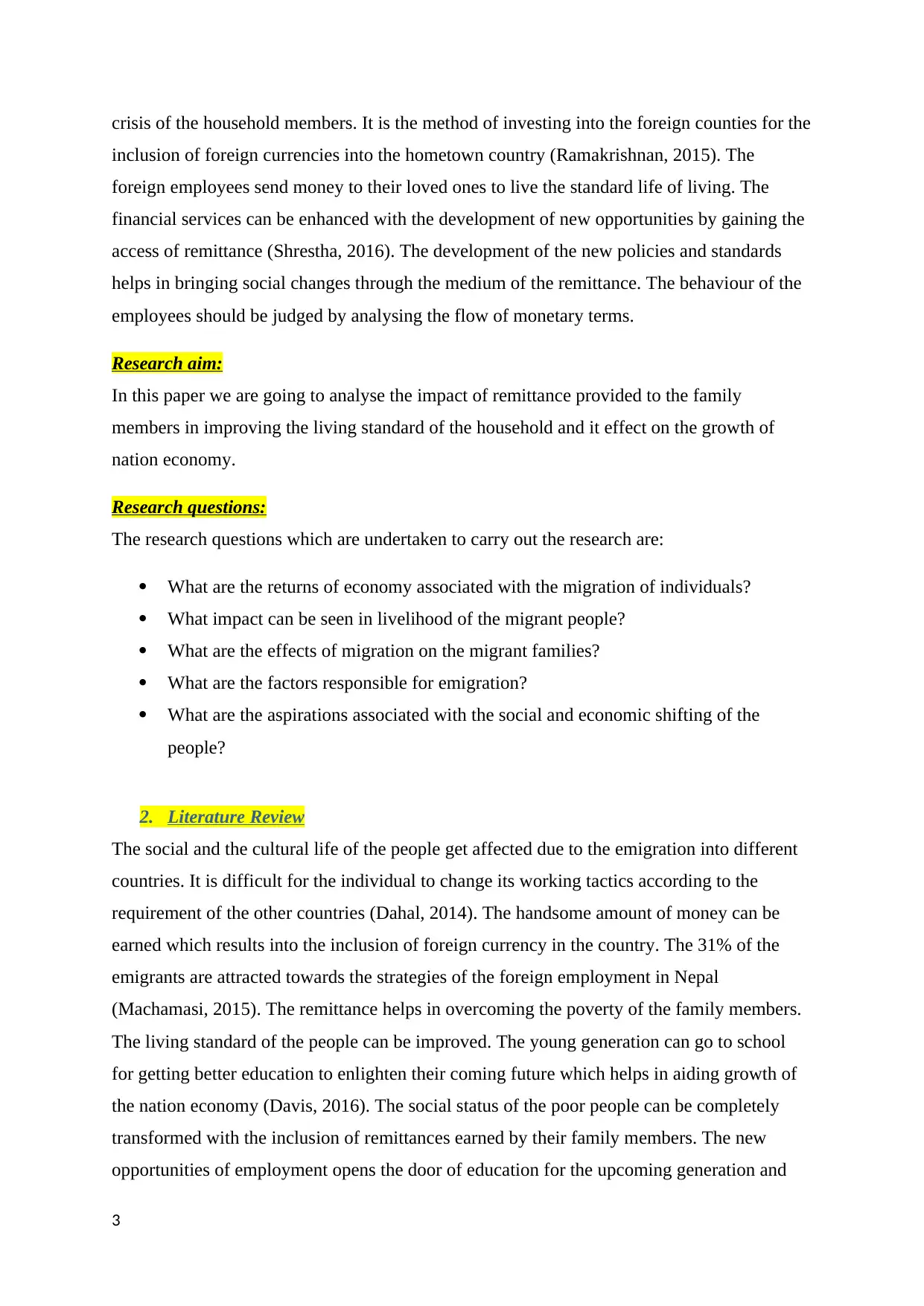
crisis of the household members. It is the method of investing into the foreign counties for the
inclusion of foreign currencies into the hometown country (Ramakrishnan, 2015). The
foreign employees send money to their loved ones to live the standard life of living. The
financial services can be enhanced with the development of new opportunities by gaining the
access of remittance (Shrestha, 2016). The development of the new policies and standards
helps in bringing social changes through the medium of the remittance. The behaviour of the
employees should be judged by analysing the flow of monetary terms.
Research aim:
In this paper we are going to analyse the impact of remittance provided to the family
members in improving the living standard of the household and it effect on the growth of
nation economy.
Research questions:
The research questions which are undertaken to carry out the research are:
What are the returns of economy associated with the migration of individuals?
What impact can be seen in livelihood of the migrant people?
What are the effects of migration on the migrant families?
What are the factors responsible for emigration?
What are the aspirations associated with the social and economic shifting of the
people?
2. Literature Review
The social and the cultural life of the people get affected due to the emigration into different
countries. It is difficult for the individual to change its working tactics according to the
requirement of the other countries (Dahal, 2014). The handsome amount of money can be
earned which results into the inclusion of foreign currency in the country. The 31% of the
emigrants are attracted towards the strategies of the foreign employment in Nepal
(Machamasi, 2015). The remittance helps in overcoming the poverty of the family members.
The living standard of the people can be improved. The young generation can go to school
for getting better education to enlighten their coming future which helps in aiding growth of
the nation economy (Davis, 2016). The social status of the poor people can be completely
transformed with the inclusion of remittances earned by their family members. The new
opportunities of employment opens the door of education for the upcoming generation and
3
inclusion of foreign currencies into the hometown country (Ramakrishnan, 2015). The
foreign employees send money to their loved ones to live the standard life of living. The
financial services can be enhanced with the development of new opportunities by gaining the
access of remittance (Shrestha, 2016). The development of the new policies and standards
helps in bringing social changes through the medium of the remittance. The behaviour of the
employees should be judged by analysing the flow of monetary terms.
Research aim:
In this paper we are going to analyse the impact of remittance provided to the family
members in improving the living standard of the household and it effect on the growth of
nation economy.
Research questions:
The research questions which are undertaken to carry out the research are:
What are the returns of economy associated with the migration of individuals?
What impact can be seen in livelihood of the migrant people?
What are the effects of migration on the migrant families?
What are the factors responsible for emigration?
What are the aspirations associated with the social and economic shifting of the
people?
2. Literature Review
The social and the cultural life of the people get affected due to the emigration into different
countries. It is difficult for the individual to change its working tactics according to the
requirement of the other countries (Dahal, 2014). The handsome amount of money can be
earned which results into the inclusion of foreign currency in the country. The 31% of the
emigrants are attracted towards the strategies of the foreign employment in Nepal
(Machamasi, 2015). The remittance helps in overcoming the poverty of the family members.
The living standard of the people can be improved. The young generation can go to school
for getting better education to enlighten their coming future which helps in aiding growth of
the nation economy (Davis, 2016). The social status of the poor people can be completely
transformed with the inclusion of remittances earned by their family members. The new
opportunities of employment opens the door of education for the upcoming generation and
3
Paraphrase This Document
Need a fresh take? Get an instant paraphrase of this document with our AI Paraphraser
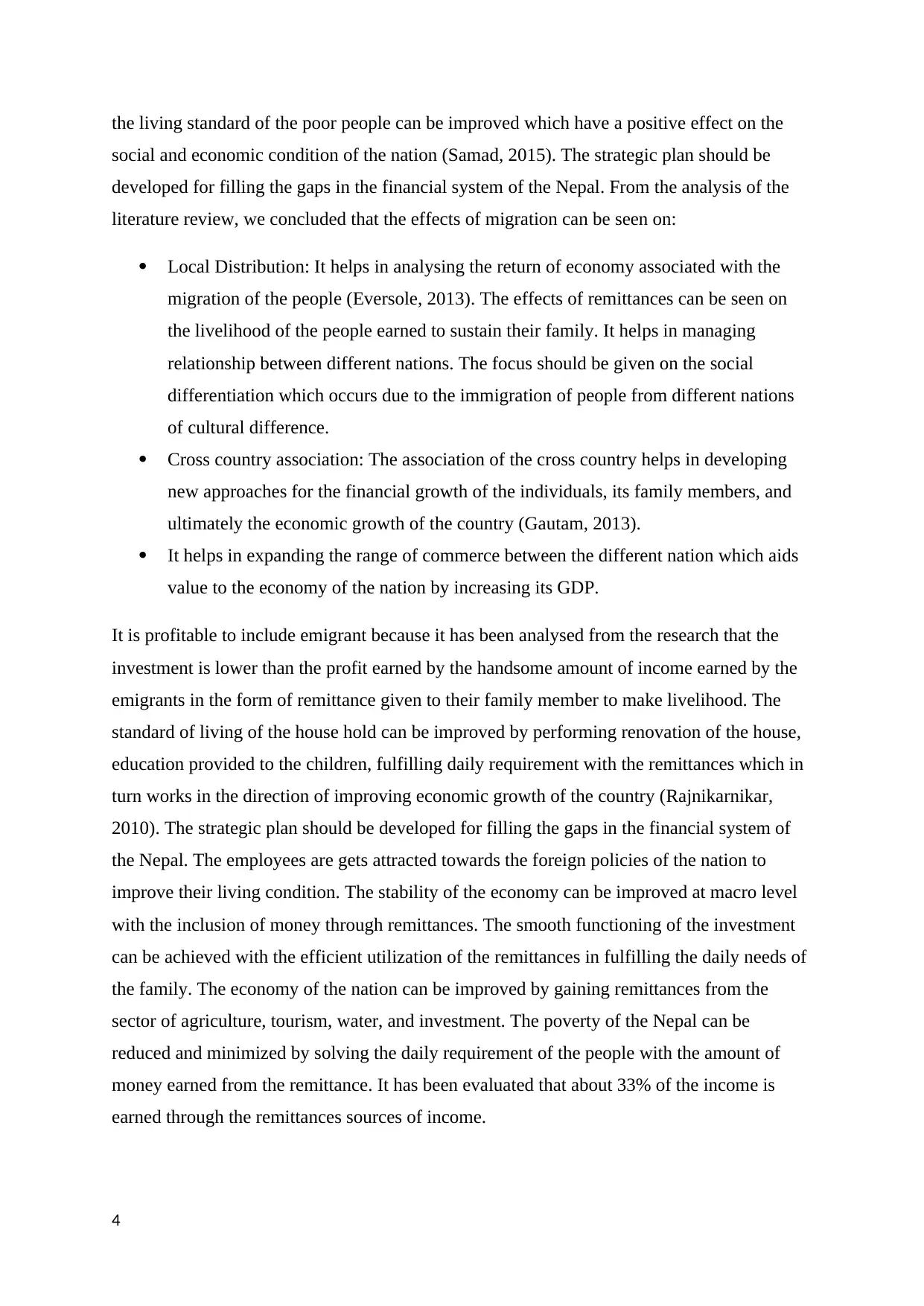
the living standard of the poor people can be improved which have a positive effect on the
social and economic condition of the nation (Samad, 2015). The strategic plan should be
developed for filling the gaps in the financial system of the Nepal. From the analysis of the
literature review, we concluded that the effects of migration can be seen on:
Local Distribution: It helps in analysing the return of economy associated with the
migration of the people (Eversole, 2013). The effects of remittances can be seen on
the livelihood of the people earned to sustain their family. It helps in managing
relationship between different nations. The focus should be given on the social
differentiation which occurs due to the immigration of people from different nations
of cultural difference.
Cross country association: The association of the cross country helps in developing
new approaches for the financial growth of the individuals, its family members, and
ultimately the economic growth of the country (Gautam, 2013).
It helps in expanding the range of commerce between the different nation which aids
value to the economy of the nation by increasing its GDP.
It is profitable to include emigrant because it has been analysed from the research that the
investment is lower than the profit earned by the handsome amount of income earned by the
emigrants in the form of remittance given to their family member to make livelihood. The
standard of living of the house hold can be improved by performing renovation of the house,
education provided to the children, fulfilling daily requirement with the remittances which in
turn works in the direction of improving economic growth of the country (Rajnikarnikar,
2010). The strategic plan should be developed for filling the gaps in the financial system of
the Nepal. The employees are gets attracted towards the foreign policies of the nation to
improve their living condition. The stability of the economy can be improved at macro level
with the inclusion of money through remittances. The smooth functioning of the investment
can be achieved with the efficient utilization of the remittances in fulfilling the daily needs of
the family. The economy of the nation can be improved by gaining remittances from the
sector of agriculture, tourism, water, and investment. The poverty of the Nepal can be
reduced and minimized by solving the daily requirement of the people with the amount of
money earned from the remittance. It has been evaluated that about 33% of the income is
earned through the remittances sources of income.
4
social and economic condition of the nation (Samad, 2015). The strategic plan should be
developed for filling the gaps in the financial system of the Nepal. From the analysis of the
literature review, we concluded that the effects of migration can be seen on:
Local Distribution: It helps in analysing the return of economy associated with the
migration of the people (Eversole, 2013). The effects of remittances can be seen on
the livelihood of the people earned to sustain their family. It helps in managing
relationship between different nations. The focus should be given on the social
differentiation which occurs due to the immigration of people from different nations
of cultural difference.
Cross country association: The association of the cross country helps in developing
new approaches for the financial growth of the individuals, its family members, and
ultimately the economic growth of the country (Gautam, 2013).
It helps in expanding the range of commerce between the different nation which aids
value to the economy of the nation by increasing its GDP.
It is profitable to include emigrant because it has been analysed from the research that the
investment is lower than the profit earned by the handsome amount of income earned by the
emigrants in the form of remittance given to their family member to make livelihood. The
standard of living of the house hold can be improved by performing renovation of the house,
education provided to the children, fulfilling daily requirement with the remittances which in
turn works in the direction of improving economic growth of the country (Rajnikarnikar,
2010). The strategic plan should be developed for filling the gaps in the financial system of
the Nepal. The employees are gets attracted towards the foreign policies of the nation to
improve their living condition. The stability of the economy can be improved at macro level
with the inclusion of money through remittances. The smooth functioning of the investment
can be achieved with the efficient utilization of the remittances in fulfilling the daily needs of
the family. The economy of the nation can be improved by gaining remittances from the
sector of agriculture, tourism, water, and investment. The poverty of the Nepal can be
reduced and minimized by solving the daily requirement of the people with the amount of
money earned from the remittance. It has been evaluated that about 33% of the income is
earned through the remittances sources of income.
4
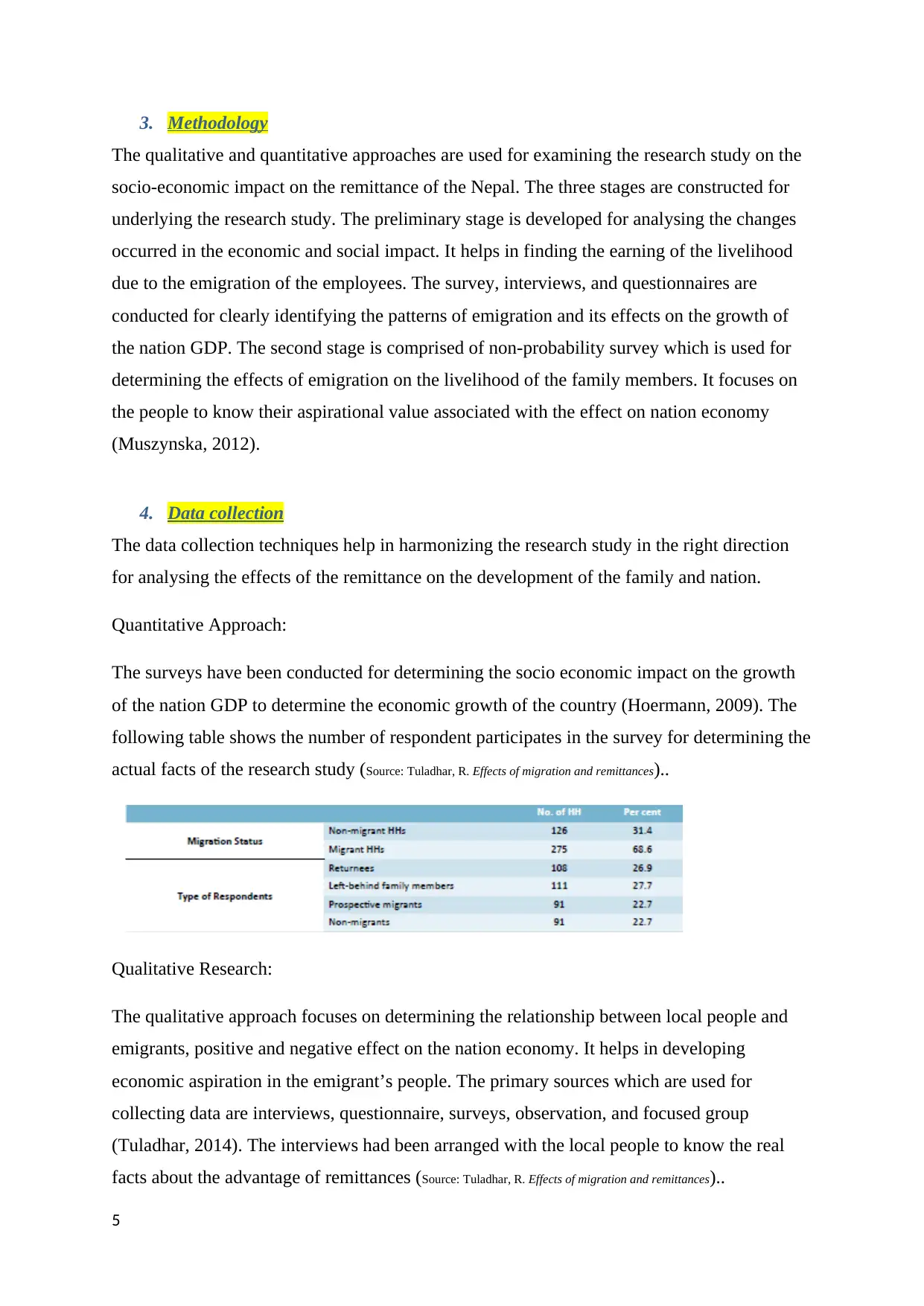
3. Methodology
The qualitative and quantitative approaches are used for examining the research study on the
socio-economic impact on the remittance of the Nepal. The three stages are constructed for
underlying the research study. The preliminary stage is developed for analysing the changes
occurred in the economic and social impact. It helps in finding the earning of the livelihood
due to the emigration of the employees. The survey, interviews, and questionnaires are
conducted for clearly identifying the patterns of emigration and its effects on the growth of
the nation GDP. The second stage is comprised of non-probability survey which is used for
determining the effects of emigration on the livelihood of the family members. It focuses on
the people to know their aspirational value associated with the effect on nation economy
(Muszynska, 2012).
4. Data collection
The data collection techniques help in harmonizing the research study in the right direction
for analysing the effects of the remittance on the development of the family and nation.
Quantitative Approach:
The surveys have been conducted for determining the socio economic impact on the growth
of the nation GDP to determine the economic growth of the country (Hoermann, 2009). The
following table shows the number of respondent participates in the survey for determining the
actual facts of the research study (Source: Tuladhar, R. Effects of migration and remittances)..
Qualitative Research:
The qualitative approach focuses on determining the relationship between local people and
emigrants, positive and negative effect on the nation economy. It helps in developing
economic aspiration in the emigrant’s people. The primary sources which are used for
collecting data are interviews, questionnaire, surveys, observation, and focused group
(Tuladhar, 2014). The interviews had been arranged with the local people to know the real
facts about the advantage of remittances (Source: Tuladhar, R. Effects of migration and remittances)..
5
The qualitative and quantitative approaches are used for examining the research study on the
socio-economic impact on the remittance of the Nepal. The three stages are constructed for
underlying the research study. The preliminary stage is developed for analysing the changes
occurred in the economic and social impact. It helps in finding the earning of the livelihood
due to the emigration of the employees. The survey, interviews, and questionnaires are
conducted for clearly identifying the patterns of emigration and its effects on the growth of
the nation GDP. The second stage is comprised of non-probability survey which is used for
determining the effects of emigration on the livelihood of the family members. It focuses on
the people to know their aspirational value associated with the effect on nation economy
(Muszynska, 2012).
4. Data collection
The data collection techniques help in harmonizing the research study in the right direction
for analysing the effects of the remittance on the development of the family and nation.
Quantitative Approach:
The surveys have been conducted for determining the socio economic impact on the growth
of the nation GDP to determine the economic growth of the country (Hoermann, 2009). The
following table shows the number of respondent participates in the survey for determining the
actual facts of the research study (Source: Tuladhar, R. Effects of migration and remittances)..
Qualitative Research:
The qualitative approach focuses on determining the relationship between local people and
emigrants, positive and negative effect on the nation economy. It helps in developing
economic aspiration in the emigrant’s people. The primary sources which are used for
collecting data are interviews, questionnaire, surveys, observation, and focused group
(Tuladhar, 2014). The interviews had been arranged with the local people to know the real
facts about the advantage of remittances (Source: Tuladhar, R. Effects of migration and remittances)..
5
⊘ This is a preview!⊘
Do you want full access?
Subscribe today to unlock all pages.

Trusted by 1+ million students worldwide
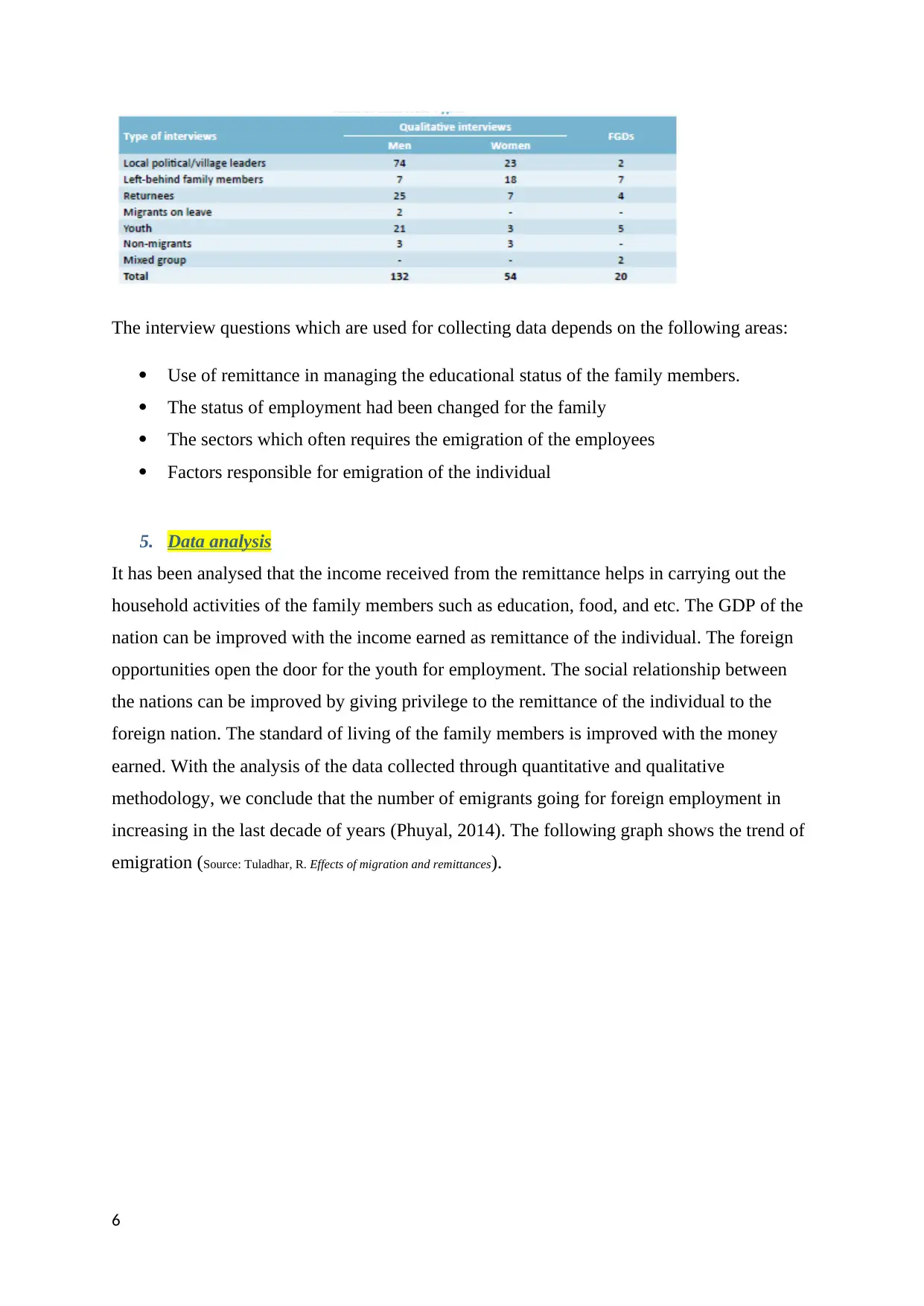
The interview questions which are used for collecting data depends on the following areas:
Use of remittance in managing the educational status of the family members.
The status of employment had been changed for the family
The sectors which often requires the emigration of the employees
Factors responsible for emigration of the individual
5. Data analysis
It has been analysed that the income received from the remittance helps in carrying out the
household activities of the family members such as education, food, and etc. The GDP of the
nation can be improved with the income earned as remittance of the individual. The foreign
opportunities open the door for the youth for employment. The social relationship between
the nations can be improved by giving privilege to the remittance of the individual to the
foreign nation. The standard of living of the family members is improved with the money
earned. With the analysis of the data collected through quantitative and qualitative
methodology, we conclude that the number of emigrants going for foreign employment in
increasing in the last decade of years (Phuyal, 2014). The following graph shows the trend of
emigration (Source: Tuladhar, R. Effects of migration and remittances).
6
Use of remittance in managing the educational status of the family members.
The status of employment had been changed for the family
The sectors which often requires the emigration of the employees
Factors responsible for emigration of the individual
5. Data analysis
It has been analysed that the income received from the remittance helps in carrying out the
household activities of the family members such as education, food, and etc. The GDP of the
nation can be improved with the income earned as remittance of the individual. The foreign
opportunities open the door for the youth for employment. The social relationship between
the nations can be improved by giving privilege to the remittance of the individual to the
foreign nation. The standard of living of the family members is improved with the money
earned. With the analysis of the data collected through quantitative and qualitative
methodology, we conclude that the number of emigrants going for foreign employment in
increasing in the last decade of years (Phuyal, 2014). The following graph shows the trend of
emigration (Source: Tuladhar, R. Effects of migration and remittances).
6
Paraphrase This Document
Need a fresh take? Get an instant paraphrase of this document with our AI Paraphraser
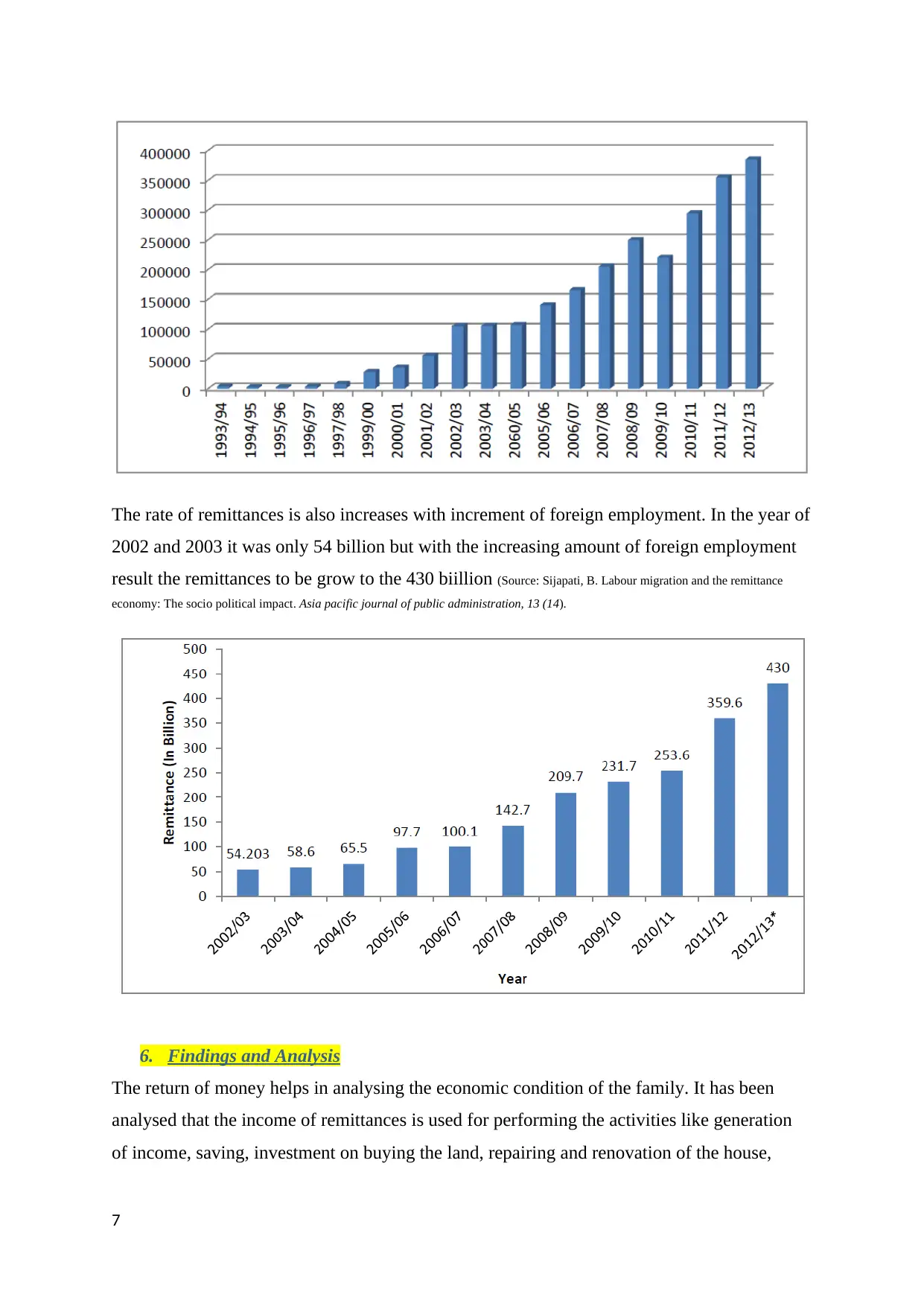
The rate of remittances is also increases with increment of foreign employment. In the year of
2002 and 2003 it was only 54 billion but with the increasing amount of foreign employment
result the remittances to be grow to the 430 biillion (Source: Sijapati, B. Labour migration and the remittance
economy: The socio political impact. Asia pacific journal of public administration, 13 (14).
6. Findings and Analysis
The return of money helps in analysing the economic condition of the family. It has been
analysed that the income of remittances is used for performing the activities like generation
of income, saving, investment on buying the land, repairing and renovation of the house,
7
2002 and 2003 it was only 54 billion but with the increasing amount of foreign employment
result the remittances to be grow to the 430 biillion (Source: Sijapati, B. Labour migration and the remittance
economy: The socio political impact. Asia pacific journal of public administration, 13 (14).
6. Findings and Analysis
The return of money helps in analysing the economic condition of the family. It has been
analysed that the income of remittances is used for performing the activities like generation
of income, saving, investment on buying the land, repairing and renovation of the house,
7
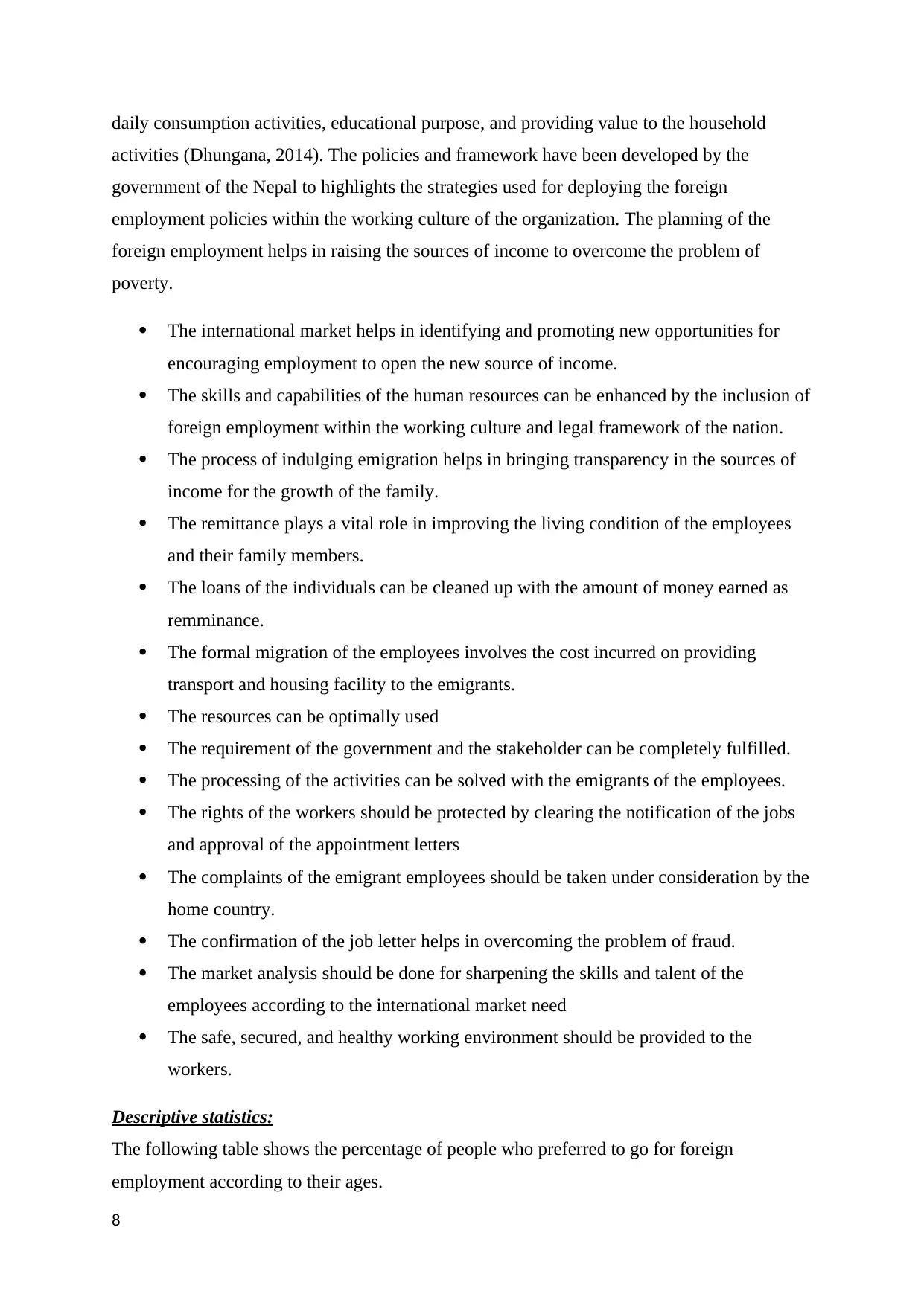
daily consumption activities, educational purpose, and providing value to the household
activities (Dhungana, 2014). The policies and framework have been developed by the
government of the Nepal to highlights the strategies used for deploying the foreign
employment policies within the working culture of the organization. The planning of the
foreign employment helps in raising the sources of income to overcome the problem of
poverty.
The international market helps in identifying and promoting new opportunities for
encouraging employment to open the new source of income.
The skills and capabilities of the human resources can be enhanced by the inclusion of
foreign employment within the working culture and legal framework of the nation.
The process of indulging emigration helps in bringing transparency in the sources of
income for the growth of the family.
The remittance plays a vital role in improving the living condition of the employees
and their family members.
The loans of the individuals can be cleaned up with the amount of money earned as
remminance.
The formal migration of the employees involves the cost incurred on providing
transport and housing facility to the emigrants.
The resources can be optimally used
The requirement of the government and the stakeholder can be completely fulfilled.
The processing of the activities can be solved with the emigrants of the employees.
The rights of the workers should be protected by clearing the notification of the jobs
and approval of the appointment letters
The complaints of the emigrant employees should be taken under consideration by the
home country.
The confirmation of the job letter helps in overcoming the problem of fraud.
The market analysis should be done for sharpening the skills and talent of the
employees according to the international market need
The safe, secured, and healthy working environment should be provided to the
workers.
Descriptive statistics:
The following table shows the percentage of people who preferred to go for foreign
employment according to their ages.
8
activities (Dhungana, 2014). The policies and framework have been developed by the
government of the Nepal to highlights the strategies used for deploying the foreign
employment policies within the working culture of the organization. The planning of the
foreign employment helps in raising the sources of income to overcome the problem of
poverty.
The international market helps in identifying and promoting new opportunities for
encouraging employment to open the new source of income.
The skills and capabilities of the human resources can be enhanced by the inclusion of
foreign employment within the working culture and legal framework of the nation.
The process of indulging emigration helps in bringing transparency in the sources of
income for the growth of the family.
The remittance plays a vital role in improving the living condition of the employees
and their family members.
The loans of the individuals can be cleaned up with the amount of money earned as
remminance.
The formal migration of the employees involves the cost incurred on providing
transport and housing facility to the emigrants.
The resources can be optimally used
The requirement of the government and the stakeholder can be completely fulfilled.
The processing of the activities can be solved with the emigrants of the employees.
The rights of the workers should be protected by clearing the notification of the jobs
and approval of the appointment letters
The complaints of the emigrant employees should be taken under consideration by the
home country.
The confirmation of the job letter helps in overcoming the problem of fraud.
The market analysis should be done for sharpening the skills and talent of the
employees according to the international market need
The safe, secured, and healthy working environment should be provided to the
workers.
Descriptive statistics:
The following table shows the percentage of people who preferred to go for foreign
employment according to their ages.
8
⊘ This is a preview!⊘
Do you want full access?
Subscribe today to unlock all pages.

Trusted by 1+ million students worldwide
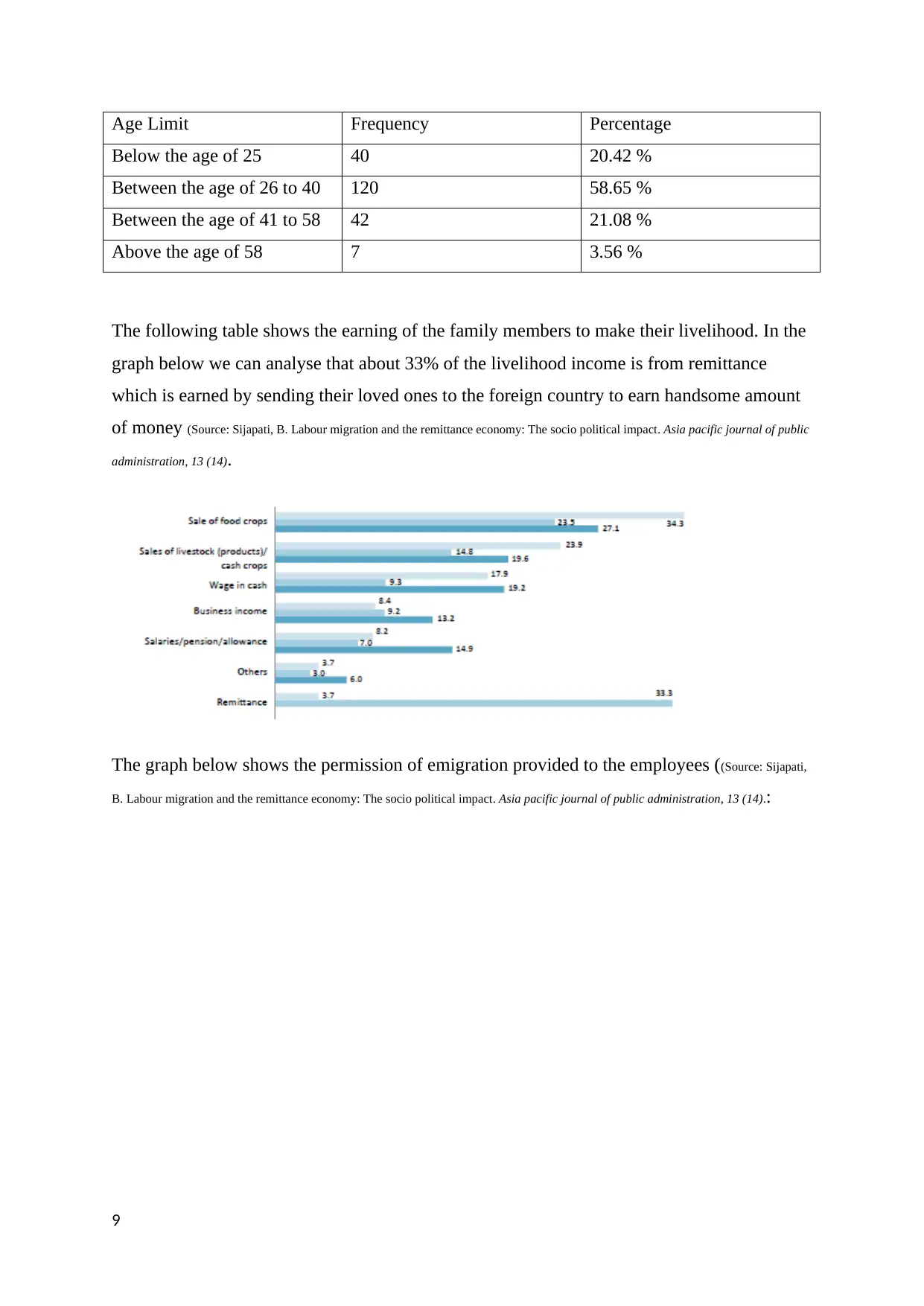
Age Limit Frequency Percentage
Below the age of 25 40 20.42 %
Between the age of 26 to 40 120 58.65 %
Between the age of 41 to 58 42 21.08 %
Above the age of 58 7 3.56 %
The following table shows the earning of the family members to make their livelihood. In the
graph below we can analyse that about 33% of the livelihood income is from remittance
which is earned by sending their loved ones to the foreign country to earn handsome amount
of money (Source: Sijapati, B. Labour migration and the remittance economy: The socio political impact. Asia pacific journal of public
administration, 13 (14).
The graph below shows the permission of emigration provided to the employees ((Source: Sijapati,
B. Labour migration and the remittance economy: The socio political impact. Asia pacific journal of public administration, 13 (14).:
9
Below the age of 25 40 20.42 %
Between the age of 26 to 40 120 58.65 %
Between the age of 41 to 58 42 21.08 %
Above the age of 58 7 3.56 %
The following table shows the earning of the family members to make their livelihood. In the
graph below we can analyse that about 33% of the livelihood income is from remittance
which is earned by sending their loved ones to the foreign country to earn handsome amount
of money (Source: Sijapati, B. Labour migration and the remittance economy: The socio political impact. Asia pacific journal of public
administration, 13 (14).
The graph below shows the permission of emigration provided to the employees ((Source: Sijapati,
B. Labour migration and the remittance economy: The socio political impact. Asia pacific journal of public administration, 13 (14).:
9
Paraphrase This Document
Need a fresh take? Get an instant paraphrase of this document with our AI Paraphraser
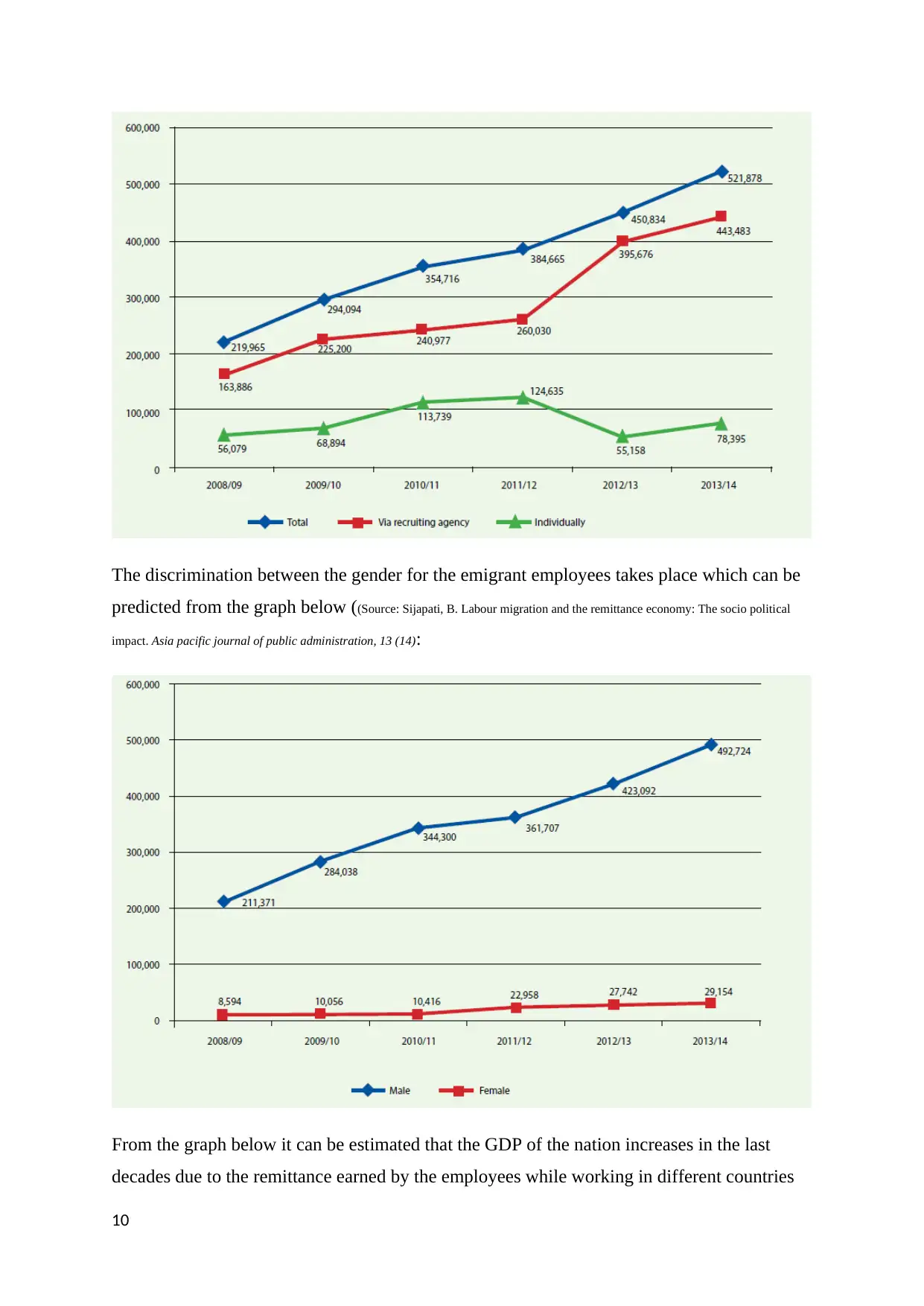
The discrimination between the gender for the emigrant employees takes place which can be
predicted from the graph below ((Source: Sijapati, B. Labour migration and the remittance economy: The socio political
impact. Asia pacific journal of public administration, 13 (14):
From the graph below it can be estimated that the GDP of the nation increases in the last
decades due to the remittance earned by the employees while working in different countries
10
predicted from the graph below ((Source: Sijapati, B. Labour migration and the remittance economy: The socio political
impact. Asia pacific journal of public administration, 13 (14):
From the graph below it can be estimated that the GDP of the nation increases in the last
decades due to the remittance earned by the employees while working in different countries
10

(Source: Davis, J. Migration remittances and nutrition outcome of left behind children. International Journal of economic and finance,
10(13)).
The inclusion of foreign exchange and currency in the Nepal helps in raising the GDP ratio of
the country (Ajaero, 2013). The change in currency helps in increasing the economic growth
of the country. The higher economic growth can be estimated from the graph below (Source:
Davis, J. Migration remittances and nutrition outcome of left behind children. International Journal of economic and finance, 10(13)).
:
The earning of the country is increased with the inclusion of foreign currency with the help of
remittances provided to the household members of the family (Pandit, 2014). The remittance
helps in filling the gap exist between the inclusion of the foreign exchange which works on
increasing values to the economic standard of the Nepal.
7. Discussion
From the undertaking of the research study, we are able to identify the factors responsible for
the emigration of the individual. The factors are classified into two categories which are
named as Push factors and Pull factors. The push factor comply the employees to emigrant to
the foreign country due to the poor living standard of the families (Kamutela, 2012). The
emigration gives the potential insurance about the remittance which can be earned by the
individual to improve the living condition of the family and which in turn helps in aiding
value to the economic sector of the country. The daily requirement of the family members
can be fulfilled with ease. The education can be provided to the young ones to make their
bright future. The health of the family can be improved by overcoming the problem of
malnutrition. The pull factor is responsible for attracting individual towards the foreign
11
10(13)).
The inclusion of foreign exchange and currency in the Nepal helps in raising the GDP ratio of
the country (Ajaero, 2013). The change in currency helps in increasing the economic growth
of the country. The higher economic growth can be estimated from the graph below (Source:
Davis, J. Migration remittances and nutrition outcome of left behind children. International Journal of economic and finance, 10(13)).
:
The earning of the country is increased with the inclusion of foreign currency with the help of
remittances provided to the household members of the family (Pandit, 2014). The remittance
helps in filling the gap exist between the inclusion of the foreign exchange which works on
increasing values to the economic standard of the Nepal.
7. Discussion
From the undertaking of the research study, we are able to identify the factors responsible for
the emigration of the individual. The factors are classified into two categories which are
named as Push factors and Pull factors. The push factor comply the employees to emigrant to
the foreign country due to the poor living standard of the families (Kamutela, 2012). The
emigration gives the potential insurance about the remittance which can be earned by the
individual to improve the living condition of the family and which in turn helps in aiding
value to the economic sector of the country. The daily requirement of the family members
can be fulfilled with ease. The education can be provided to the young ones to make their
bright future. The health of the family can be improved by overcoming the problem of
malnutrition. The pull factor is responsible for attracting individual towards the foreign
11
⊘ This is a preview!⊘
Do you want full access?
Subscribe today to unlock all pages.

Trusted by 1+ million students worldwide
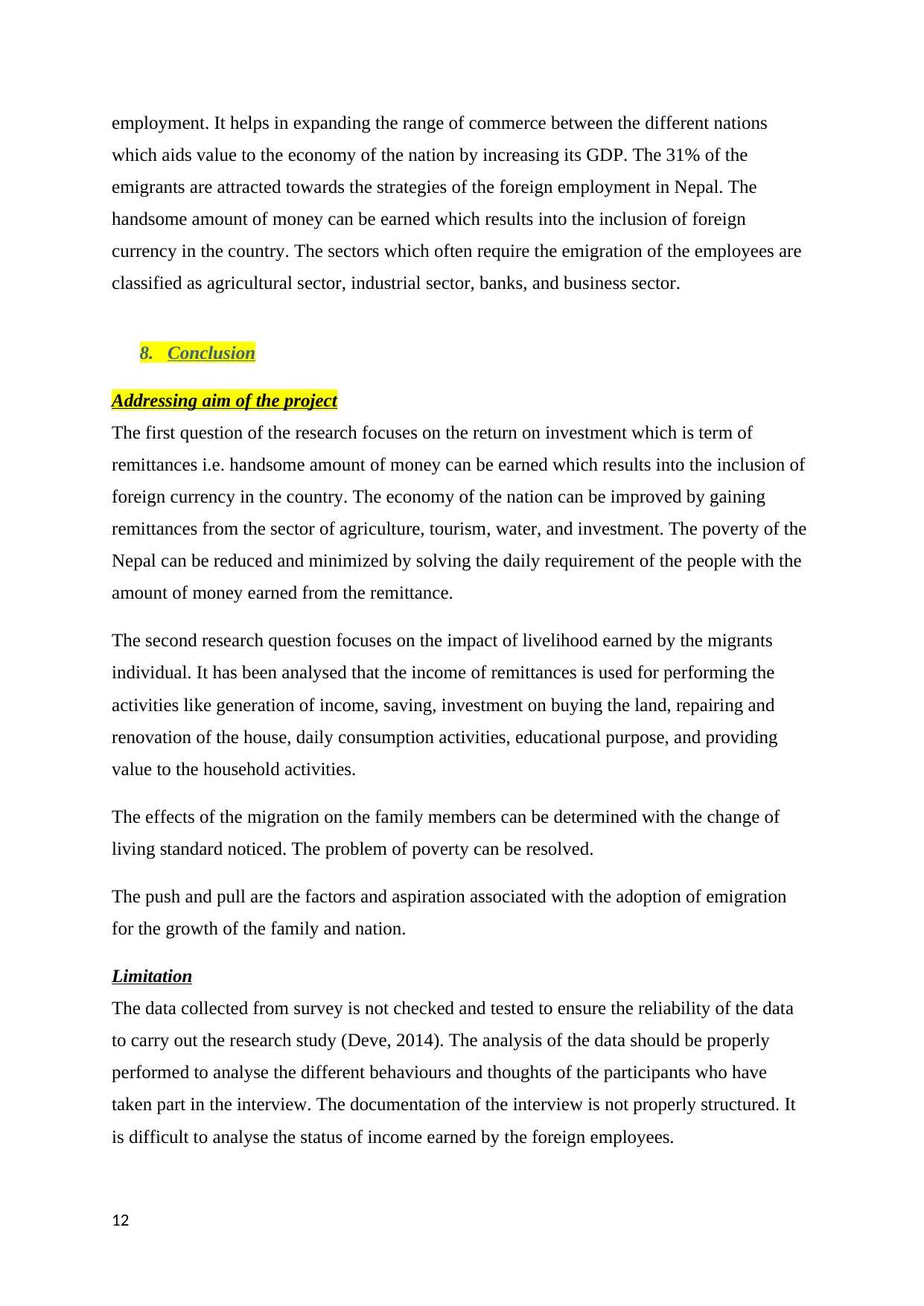
employment. It helps in expanding the range of commerce between the different nations
which aids value to the economy of the nation by increasing its GDP. The 31% of the
emigrants are attracted towards the strategies of the foreign employment in Nepal. The
handsome amount of money can be earned which results into the inclusion of foreign
currency in the country. The sectors which often require the emigration of the employees are
classified as agricultural sector, industrial sector, banks, and business sector.
8. Conclusion
Addressing aim of the project
The first question of the research focuses on the return on investment which is term of
remittances i.e. handsome amount of money can be earned which results into the inclusion of
foreign currency in the country. The economy of the nation can be improved by gaining
remittances from the sector of agriculture, tourism, water, and investment. The poverty of the
Nepal can be reduced and minimized by solving the daily requirement of the people with the
amount of money earned from the remittance.
The second research question focuses on the impact of livelihood earned by the migrants
individual. It has been analysed that the income of remittances is used for performing the
activities like generation of income, saving, investment on buying the land, repairing and
renovation of the house, daily consumption activities, educational purpose, and providing
value to the household activities.
The effects of the migration on the family members can be determined with the change of
living standard noticed. The problem of poverty can be resolved.
The push and pull are the factors and aspiration associated with the adoption of emigration
for the growth of the family and nation.
Limitation
The data collected from survey is not checked and tested to ensure the reliability of the data
to carry out the research study (Deve, 2014). The analysis of the data should be properly
performed to analyse the different behaviours and thoughts of the participants who have
taken part in the interview. The documentation of the interview is not properly structured. It
is difficult to analyse the status of income earned by the foreign employees.
12
which aids value to the economy of the nation by increasing its GDP. The 31% of the
emigrants are attracted towards the strategies of the foreign employment in Nepal. The
handsome amount of money can be earned which results into the inclusion of foreign
currency in the country. The sectors which often require the emigration of the employees are
classified as agricultural sector, industrial sector, banks, and business sector.
8. Conclusion
Addressing aim of the project
The first question of the research focuses on the return on investment which is term of
remittances i.e. handsome amount of money can be earned which results into the inclusion of
foreign currency in the country. The economy of the nation can be improved by gaining
remittances from the sector of agriculture, tourism, water, and investment. The poverty of the
Nepal can be reduced and minimized by solving the daily requirement of the people with the
amount of money earned from the remittance.
The second research question focuses on the impact of livelihood earned by the migrants
individual. It has been analysed that the income of remittances is used for performing the
activities like generation of income, saving, investment on buying the land, repairing and
renovation of the house, daily consumption activities, educational purpose, and providing
value to the household activities.
The effects of the migration on the family members can be determined with the change of
living standard noticed. The problem of poverty can be resolved.
The push and pull are the factors and aspiration associated with the adoption of emigration
for the growth of the family and nation.
Limitation
The data collected from survey is not checked and tested to ensure the reliability of the data
to carry out the research study (Deve, 2014). The analysis of the data should be properly
performed to analyse the different behaviours and thoughts of the participants who have
taken part in the interview. The documentation of the interview is not properly structured. It
is difficult to analyse the status of income earned by the foreign employees.
12
Paraphrase This Document
Need a fresh take? Get an instant paraphrase of this document with our AI Paraphraser
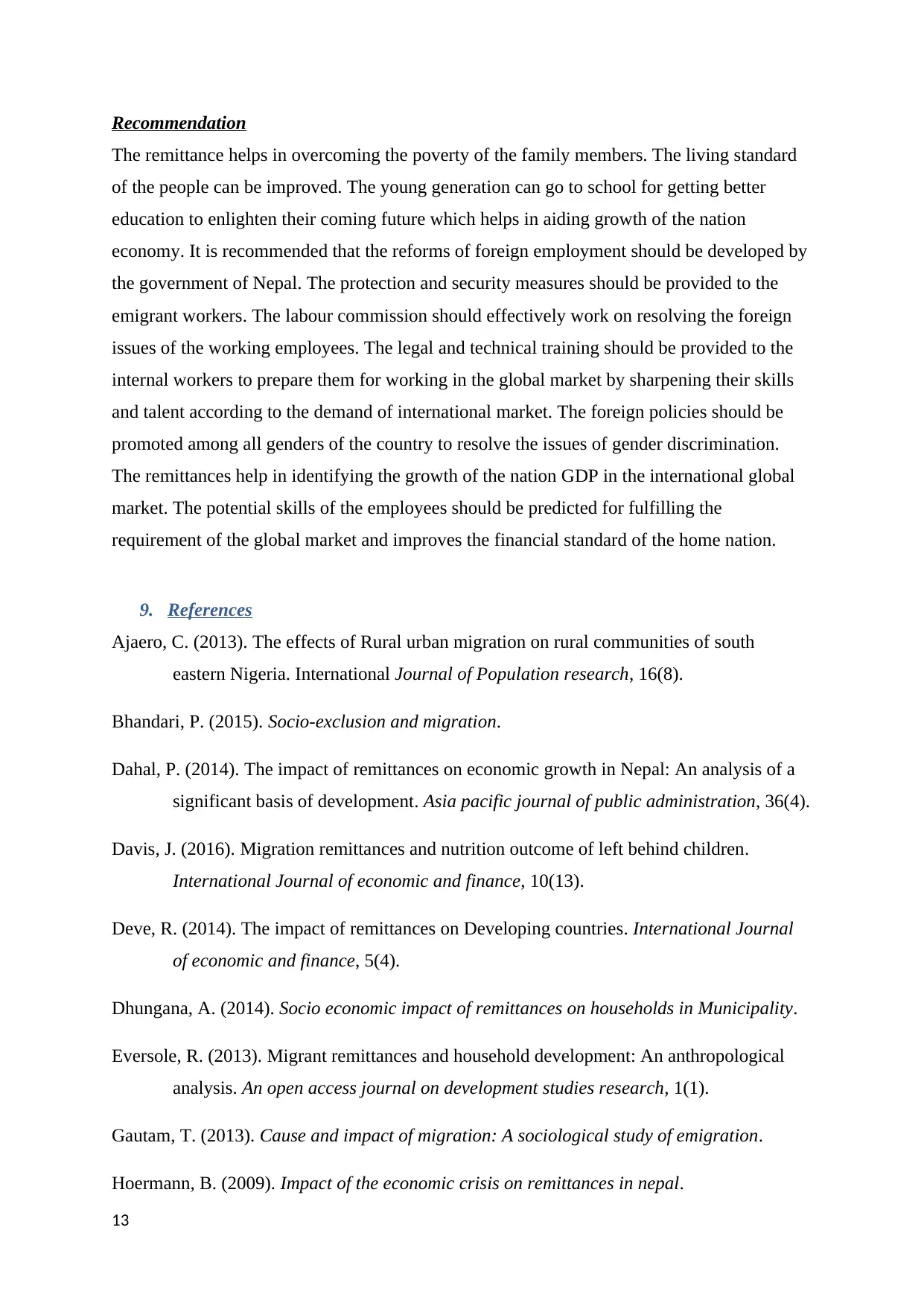
Recommendation
The remittance helps in overcoming the poverty of the family members. The living standard
of the people can be improved. The young generation can go to school for getting better
education to enlighten their coming future which helps in aiding growth of the nation
economy. It is recommended that the reforms of foreign employment should be developed by
the government of Nepal. The protection and security measures should be provided to the
emigrant workers. The labour commission should effectively work on resolving the foreign
issues of the working employees. The legal and technical training should be provided to the
internal workers to prepare them for working in the global market by sharpening their skills
and talent according to the demand of international market. The foreign policies should be
promoted among all genders of the country to resolve the issues of gender discrimination.
The remittances help in identifying the growth of the nation GDP in the international global
market. The potential skills of the employees should be predicted for fulfilling the
requirement of the global market and improves the financial standard of the home nation.
9. References
Ajaero, C. (2013). The effects of Rural urban migration on rural communities of south
eastern Nigeria. International Journal of Population research, 16(8).
Bhandari, P. (2015). Socio-exclusion and migration.
Dahal, P. (2014). The impact of remittances on economic growth in Nepal: An analysis of a
significant basis of development. Asia pacific journal of public administration, 36(4).
Davis, J. (2016). Migration remittances and nutrition outcome of left behind children.
International Journal of economic and finance, 10(13).
Deve, R. (2014). The impact of remittances on Developing countries. International Journal
of economic and finance, 5(4).
Dhungana, A. (2014). Socio economic impact of remittances on households in Municipality.
Eversole, R. (2013). Migrant remittances and household development: An anthropological
analysis. An open access journal on development studies research, 1(1).
Gautam, T. (2013). Cause and impact of migration: A sociological study of emigration.
Hoermann, B. (2009). Impact of the economic crisis on remittances in nepal.
13
The remittance helps in overcoming the poverty of the family members. The living standard
of the people can be improved. The young generation can go to school for getting better
education to enlighten their coming future which helps in aiding growth of the nation
economy. It is recommended that the reforms of foreign employment should be developed by
the government of Nepal. The protection and security measures should be provided to the
emigrant workers. The labour commission should effectively work on resolving the foreign
issues of the working employees. The legal and technical training should be provided to the
internal workers to prepare them for working in the global market by sharpening their skills
and talent according to the demand of international market. The foreign policies should be
promoted among all genders of the country to resolve the issues of gender discrimination.
The remittances help in identifying the growth of the nation GDP in the international global
market. The potential skills of the employees should be predicted for fulfilling the
requirement of the global market and improves the financial standard of the home nation.
9. References
Ajaero, C. (2013). The effects of Rural urban migration on rural communities of south
eastern Nigeria. International Journal of Population research, 16(8).
Bhandari, P. (2015). Socio-exclusion and migration.
Dahal, P. (2014). The impact of remittances on economic growth in Nepal: An analysis of a
significant basis of development. Asia pacific journal of public administration, 36(4).
Davis, J. (2016). Migration remittances and nutrition outcome of left behind children.
International Journal of economic and finance, 10(13).
Deve, R. (2014). The impact of remittances on Developing countries. International Journal
of economic and finance, 5(4).
Dhungana, A. (2014). Socio economic impact of remittances on households in Municipality.
Eversole, R. (2013). Migrant remittances and household development: An anthropological
analysis. An open access journal on development studies research, 1(1).
Gautam, T. (2013). Cause and impact of migration: A sociological study of emigration.
Hoermann, B. (2009). Impact of the economic crisis on remittances in nepal.
13
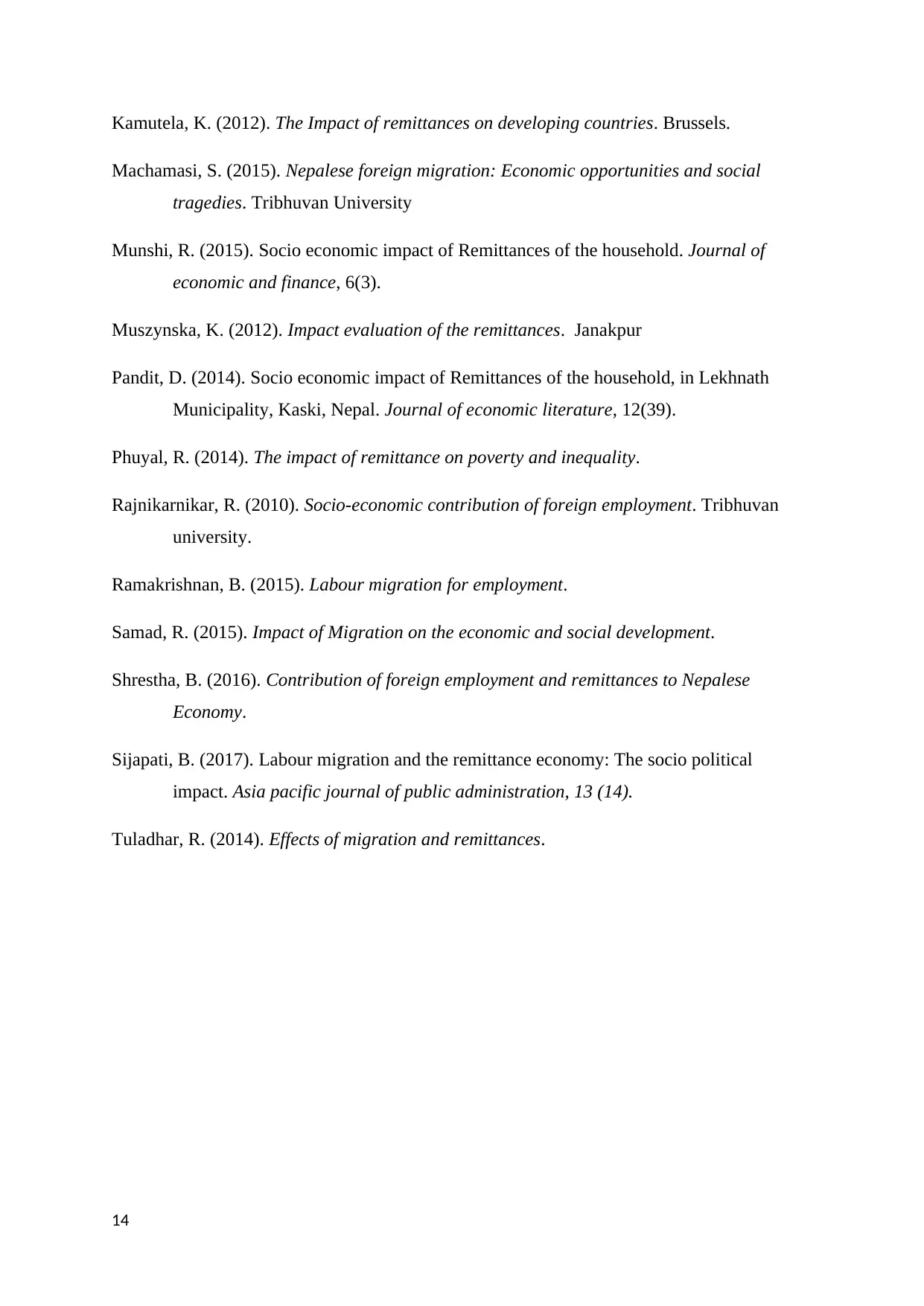
Kamutela, K. (2012). The Impact of remittances on developing countries. Brussels.
Machamasi, S. (2015). Nepalese foreign migration: Economic opportunities and social
tragedies. Tribhuvan University
Munshi, R. (2015). Socio economic impact of Remittances of the household. Journal of
economic and finance, 6(3).
Muszynska, K. (2012). Impact evaluation of the remittances. Janakpur
Pandit, D. (2014). Socio economic impact of Remittances of the household, in Lekhnath
Municipality, Kaski, Nepal. Journal of economic literature, 12(39).
Phuyal, R. (2014). The impact of remittance on poverty and inequality.
Rajnikarnikar, R. (2010). Socio-economic contribution of foreign employment. Tribhuvan
university.
Ramakrishnan, B. (2015). Labour migration for employment.
Samad, R. (2015). Impact of Migration on the economic and social development.
Shrestha, B. (2016). Contribution of foreign employment and remittances to Nepalese
Economy.
Sijapati, B. (2017). Labour migration and the remittance economy: The socio political
impact. Asia pacific journal of public administration, 13 (14).
Tuladhar, R. (2014). Effects of migration and remittances.
14
Machamasi, S. (2015). Nepalese foreign migration: Economic opportunities and social
tragedies. Tribhuvan University
Munshi, R. (2015). Socio economic impact of Remittances of the household. Journal of
economic and finance, 6(3).
Muszynska, K. (2012). Impact evaluation of the remittances. Janakpur
Pandit, D. (2014). Socio economic impact of Remittances of the household, in Lekhnath
Municipality, Kaski, Nepal. Journal of economic literature, 12(39).
Phuyal, R. (2014). The impact of remittance on poverty and inequality.
Rajnikarnikar, R. (2010). Socio-economic contribution of foreign employment. Tribhuvan
university.
Ramakrishnan, B. (2015). Labour migration for employment.
Samad, R. (2015). Impact of Migration on the economic and social development.
Shrestha, B. (2016). Contribution of foreign employment and remittances to Nepalese
Economy.
Sijapati, B. (2017). Labour migration and the remittance economy: The socio political
impact. Asia pacific journal of public administration, 13 (14).
Tuladhar, R. (2014). Effects of migration and remittances.
14
⊘ This is a preview!⊘
Do you want full access?
Subscribe today to unlock all pages.

Trusted by 1+ million students worldwide
1 out of 15
Related Documents
Your All-in-One AI-Powered Toolkit for Academic Success.
+13062052269
info@desklib.com
Available 24*7 on WhatsApp / Email
![[object Object]](/_next/static/media/star-bottom.7253800d.svg)
Unlock your academic potential
© 2024 | Zucol Services PVT LTD | All rights reserved.





